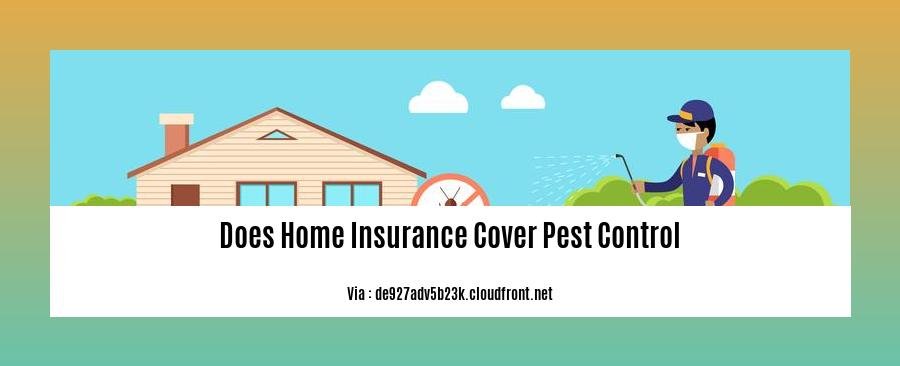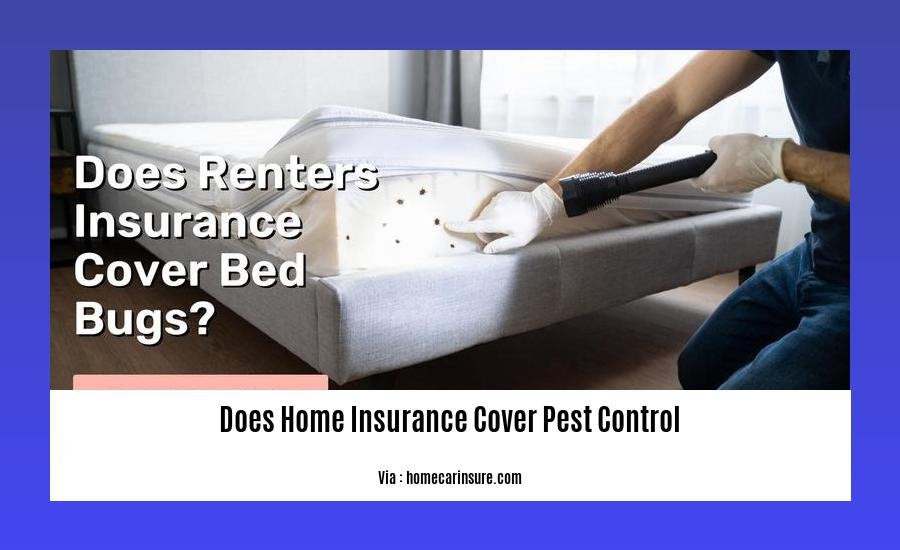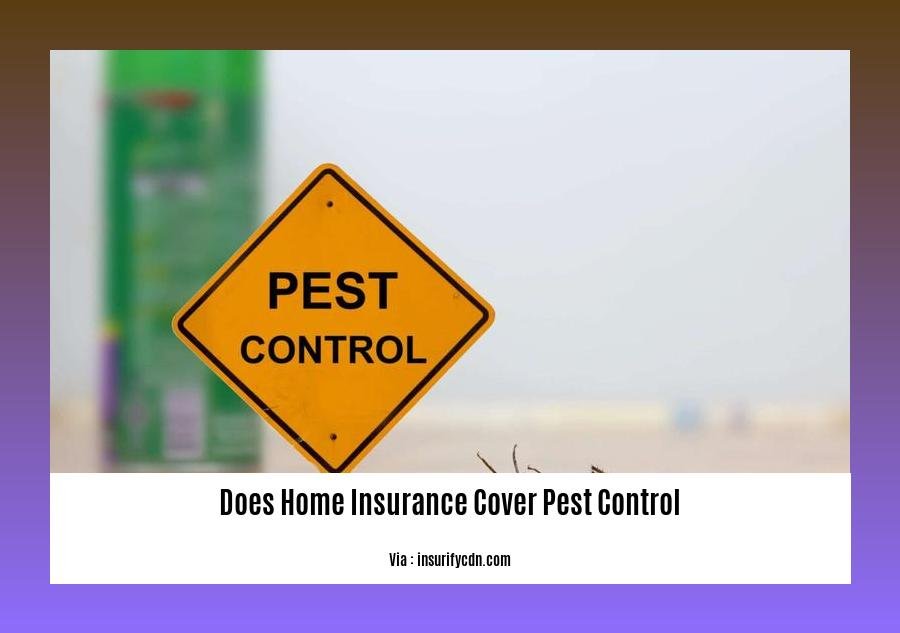Embark on a journey to unravel the intricacies of home insurance coverage when it comes to pest control in [Does Home Insurance Cover Pest Control: Unraveling the Coverage Details]. Discover the nuances of insurance policies and delve into the conditions that determine coverage for pest control measures. Gain clarity on when and how pest control expenses might be covered, ensuring you make informed decisions to protect your home and belongings from costly infestations.
Key Takeaways:
- Standard home insurance policies usually don’t include pest control coverage.
– Insurance companies see pest infestations as a result of poor upkeep and maintenance.
-
A standard home insurance covers only the perils stated in the policy details.
-
Homeowners should check their policies, consider additional coverage, and take preventive measures against pests.
Does Home Insurance Cover Pest Control?

Pest infestations can cause significant damage to your home and its contents, leading to substantial financial losses. However, it’s essential to understand that standard home insurance policies typically do not cover pest control.
Why is Pest Control Excluded from Standard Home Insurance?
Insurance companies view pest infestations as a result of poor maintenance and upkeep. They believe that homeowners are responsible for preventing pests from entering their homes, and any damage caused by pests is considered a preventable loss.
What Does Home Insurance Typically Cover?
Standard home insurance policies generally cover only the 16 perils specified in the policy details. These perils typically include sudden and accidental events such as:
- Fire
- Lightning
- Hail
- Windstorm
- Theft
- Vandalism
- Explosions
Pest infestations are not included in these perils because they are not sudden or accidental events. They are typically the result of gradual wear and tear or neglect.
Can I Purchase Additional Coverage for Pest Control?
Some insurance companies offer additional coverage for pest control as an add-on to their standard home insurance policies. This coverage may cover the cost of pest control services if you experience an infestation.
However, it’s important to note that additional coverage for pest control may not be available in all areas or from all insurance companies. It’s essential to check with your insurance provider to see if they offer this coverage and what the terms and conditions are.
Preventative Measures Against Pests
The best way to avoid the need for pest control services is to take preventative measures to keep pests out of your home. These measures include:
- Sealing cracks and gaps around doors, windows, and foundations
- Keeping your home clean and free of clutter
- Storing food in airtight containers
- Regularly inspecting your home for signs of pests
Conclusion
While standard home insurance policies do not cover pest control, there are things you can do to prevent them from infesting your home. If you do experience a pest infestation, you may be able to purchase additional coverage to help cover the cost of pest control services.
- Wondering if home insurance covers electrical issues or situations? Learn More
- Electrical issues can happen anytime and they can be quite expensive to fix. If you’re a homeowner, it’s important to make sure you have home insurance that covers electrical issues. Find Out More
- Your garage door is an important part of your home, and it’s important to make sure it’s covered by your home insurance policy. Discover if home insurance covers the repair or replacement of your garage door when it’s damaged.
- Leaking windows can cause a lot of damage to your home, and it’s important to make sure you have home insurance that covers leaking windows. Get the Details
Limitations and coverage limits for pest control under home insurance policies
Hey there, folks! Let’s dive into the world of home insurance and pest control coverage. It’s a topic that often leaves people scratching their heads. So, let’s make sense of it together.
Key Takeaways:
- Most standard home insurance policies don’t typically cover pest control.
- Insurance companies see pest infestations as preventable losses due to inadequate maintenance, gradual worsening, and lack of regular inspections.
- For instance, rodents can gnaw pipes and wiring, potentially leading to flood or fire hazards, but these damages are usually excluded.
- Cover for pest infestation is not included in most cases. Even common pests like ants, cockroaches, and spiders are typically left uncovered.
- Specialized pest control insurance policies may exist, but they’re rare and not widely available.
Types of Pests and Damages Often Excluded
Insurance companies usually exclude pest infestations from coverage. This is because they view them as gradual and preventable issues that stem from lack of maintenance. Some examples of pests and damages that are often excluded include:
- Carpenter ants, termites, carpenter bees, and powder post beetles
- Rodents, including rats and mice
- Birds and other wildlife
- Damage to structures caused by pests, such as holes in walls or damage to electrical wiring
- Costs associated with removing pests and cleaning up after an infestation
Preventing Pest Infestations: The Key to Avoiding Coverage Issues
Taking preventive measures is key to avoiding pest infestations and the need for costly treatments. Here are some proactive steps you can take:
- Seal cracks and gaps around windows, doors, and foundations.
- Keep your home clean and free of clutter.
- Regularly inspect your home for signs of pests.
- Store food in airtight containers and keep pet food in sealed containers.
When Prevention Fails: Dealing with Infestations
In case pests do invade your home, it’s important to act quickly to minimize damage and prevent the infestation from spreading.
- Identify the type of pest and the extent of the infestation.
- Contact a licensed pest control company for an assessment and treatment plan.
- Keep records of all expenses related to pest control, as you may need them for insurance claims.
Remember, prevention is always better than cure. Regular pest control and home maintenance can save you from costly infestations and insurance hassles down the road.
Citations:
Does Home Insurance Cover Pest Control?
Pest Control and Home Insurance
Exclusions and exceptions to pest control coverage under home insurance policies

Home insurance policies typically provide comprehensive coverage for various perils like fire, theft, and natural disasters. However, there are certain exclusions and exceptions to this coverage, including pest control. Understanding these limitations can help homeowners make informed decisions about their insurance coverage.
Key Takeaways:
- Standard home insurance policies generally exclude coverage for pest control services and damages caused by pest infestations.
- Insurance companies consider pest infestations a result of poor maintenance and preventable loss.
- Coverage for pest control may be available as an optional add-on or endorsement to a standard home insurance policy, but availability and terms vary among insurers.
- Homeowners can take preventive measures like sealing cracks, maintaining cleanliness, and regular inspections to minimize the risk of pest infestations.
Gradual Nature of Infestations and Exclusions:
Pest infestations often develop gradually over time, making it difficult for insurance companies to determine the exact cause and extent of the damage. In most cases, insurers view infestations as a result of poor home maintenance and a gradual worsening of the situation, which is generally not covered under standard home insurance policies.
Specific Pests and Damages Not Covered:
Common pests like ants, mice, cockroaches, and spiders are typically excluded from coverage under standard home insurance policies. This is because these pests are considered a nuisance rather than a significant hazard. Additionally, damage caused by pests like termites and rodents, which can be extensive and costly, is also generally not covered.
Availability of Pest Control Coverage as an Add-On:
Some insurance companies may offer pest control coverage as an optional add-on or endorsement to their standard home insurance policies. This coverage may include treatment for specific pests, such as termites or rodents, or it may provide reimbursement for pest control services. However, the availability and terms of this coverage vary among insurers, so homeowners should carefully review their policy details and consult with their insurance agent for more information.
Preventive Measures for Homeowners:
To minimize the risk of pest infestations and the need for pest control services, homeowners can take several preventive measures:
- Seal cracks and openings around doors, windows, and foundations to prevent pests from entering the home.
- Keep your home clean and tidy, particularly in areas where food is stored or prepared.
- Regularly inspect your home for signs of pest infestations, such as droppings, nests, or damage to property.
- Address any moisture issues promptly, as moisture can attract pests.
Conclusion:
Home insurance policies generally exclude coverage for pest control services and damages caused by pest infestations. However, homeowners can take preventive measures to minimize the risk of infestations and consult with their insurance agent about the availability of pest control coverage as an optional add-on.
Citations:
- Does Home Insurance Cover Pest Control? Understanding the Coverage
- What Does Home Insurance Cover?
Steps for Homeowners to Take When Needing Pest Control Services
When it comes to homeownership, pest control is often an unexpected challenge that can arise. Dealing with unwanted pests not only affects the comfort of your home but can also lead to costly damages. Knowing the steps to take when needing pest control services can help you address the issue effectively.
Key Takeaways:
- Home insurance policies usually don’t cover pest control.
- Certain plans might offer pest control as an add-on, but availability varies.
- Home warranties can provide coverage for pest control under specific conditions.
- Prevention is key to avoid pest infestations and potential damage.
- Seeking professional assistance ensures effective treatment and minimizes future issues.
1. Understand Your Home Insurance Coverage:
Before jumping into action, it’s essential to understand what your home insurance policy covers.
* Review your policy: Look for pest control-related coverage.
* Contact your insurance provider: Seek clarification if anything is unclear.
2. Assess the Pest Problem:
A proper assessment of the pest problem is crucial.
- Identify the type of pests: Different pests require different treatments.
- Determine the extent of the infestation: Assess the severity of the problem.
- Look for signs of damage: Inspect for potential damages caused by pests.
3. Consider a Home Warranty:
A home warranty can cover certain aspects of pest control.
- Evaluate your home warranty coverage: Check if pest control is included.
- Contact your warranty provider: Clarify any questions or concerns you have.
4. Explore Pest Prevention Measures:
Preventative measures can save you from future infestations.
- Keep your home clean: Clutter and food residue attract pests.
- Seal entry points: Seal cracks, holes, and gaps in your home’s exterior.
- Dispose of garbage properly: Use covered bins and dispose of garbage promptly.
- Maintain your yard: Trim plants and remove fallen fruits or leaves.
5. Seek Professional Pest Control Services:
When the infestation is extensive or requires specialized treatment, professional help is necessary.
- Select a reputable pest control company: Look for licensed and insured companies.
- Obtain quotes from multiple companies: Compare pricing and services offered.
- Ask about their methods: Ensure they use environmentally friendly and effective techniques.
6. Document the Pest Control Process:
Keep a record of the pest control services you receive.
- Maintain invoices and receipts: These serve as proof of payment and treatment.
- Take photos of the infestation and damage: Visual documentation can be helpful.
7. Stay Vigilant and Monitor the Situation:
Monitor your home for any signs of re-infestation.
- Regularly inspect your home: Check for new pest activity or damage.
- Follow up with the pest control company: Contact them if the problem persists.
By following these steps, you can effectively address pest control issues in your home, protect your property, and maintain a healthy and pest-free environment.
Citations:
- Does Homeowners Insurance Cover Pest Control?
- Home Warranties and Pest Control
FAQ
Q1: Does standard home insurance typically cover pest control services and damages?
A1: Typically, standard home insurance policies do not provide coverage for pest control services or damages resulting from pest infestations. Insurance companies generally consider pest infestations to be a result of inadequate maintenance and a gradual deterioration of the property.
Q2: what events or damages are usually covered by home insurance?
A2: Standard home insurance policies generally cover damages or losses caused by specific perils explicitly listed in the policy details. These perils typically include events like fire, lightning, windstorms, hail, smoke, theft, vandalism, and certain types of water damage. Pest control services and damages are not included in these standard perils.
Q3: How can homeowners protect themselves against pest infestations and associated costs?
A3: Homeowners can take several steps to protect themselves against pest infestations and associated costs:
– Regularly inspect their property for signs of pest activity and take prompt action to address any issues.
– Implement preventive measures to reduce the likelihood of infestations, such as sealing cracks and gaps in the foundation, maintaining proper ventilation, and storing food items in airtight containers.
– Consider purchasing a pest control policy or an endorsement to their existing home insurance policy that specifically covers pest control services and damages.
Q4: What are some common misconceptions about home insurance coverage for pest control?
A4: Some common misconceptions about home insurance coverage for pest control include:
– Standard home insurance policies cover any damage caused by pests, regardless of the cause.
– All pest control services and treatments are automatically covered under a standard home insurance policy.
– Home insurance will cover the costs of pest control services even if the infestation existed before the policy was purchased.
Q5: What is the role of home warranties in pest control coverage?
A5: Home warranties are service contracts that cover the repair or replacement of home systems and appliances, but they typically do not include pest control coverage. However, some home warranty companies may offer pest control coverage as an optional add-on or an extended warranty. Homeowners should carefully review the terms and conditions of their home warranty to determine if pest control coverage is included.
- Dora the Explorer Wipe-Off Fun: Safe & Mess-Free Activities for Little Explorers - April 18, 2025
- Does Lemongrass Repel Mosquitoes? Fact vs. Fiction + How to Use It - April 18, 2025
- Do Woodchucks Climb Trees?Fact vs. Fiction - April 18, 2025










